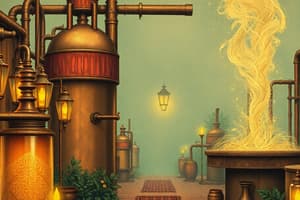Podcast
Questions and Answers
Which thermochemical conversion process is characterized by a restricted oxygen supply to produce primarily carbon monoxide?
Which thermochemical conversion process is characterized by a restricted oxygen supply to produce primarily carbon monoxide?
- Pyrolysis
- Gasification (correct)
- Combustion
- Liquefaction
Which pre-processing stage is crucial for increasing the energy density of biomass to make it more suitable for both combustion and gasification processes?
Which pre-processing stage is crucial for increasing the energy density of biomass to make it more suitable for both combustion and gasification processes?
- Densification (correct)
- Drying
- Pre-treatment
- Size Reduction
What is the primary difference between torrefaction and carbonization in thermochemical conversion?
What is the primary difference between torrefaction and carbonization in thermochemical conversion?
- Torrefaction avoids oxygen supply, whereas carbonization may use it. (correct)
- Carbonization is used in co-firing biomass, while torrefaction is not.
- Torrefaction occurs at higher temperatures than carbonization.
- Carbonization retains more volatile compounds than torrefaction.
In the context of thermochemical conversion, what is the main purpose of hydrothermal liquefaction (HTL)?
In the context of thermochemical conversion, what is the main purpose of hydrothermal liquefaction (HTL)?
How does hydro gasification enhance the quality of gas products in thermochemical conversion?
How does hydro gasification enhance the quality of gas products in thermochemical conversion?
What advantage does supercritical water gasification offer over traditional pyrolysis methods?
What advantage does supercritical water gasification offer over traditional pyrolysis methods?
Which of the following best describes why gasification, as a thermochemical process, is considered different from combustion?
Which of the following best describes why gasification, as a thermochemical process, is considered different from combustion?
In thermochemical conversion, what is the typical temperature range for pyrolysis processes?
In thermochemical conversion, what is the typical temperature range for pyrolysis processes?
What is the primary reason for using torrefaction as a pre-treatment method for biomass?
What is the primary reason for using torrefaction as a pre-treatment method for biomass?
Which thermochemical process is most suitable when the primary desired product is a liquid, leading to its frequent designation as liquefaction?
Which thermochemical process is most suitable when the primary desired product is a liquid, leading to its frequent designation as liquefaction?
What is the typical temperature needed for combustion?
What is the typical temperature needed for combustion?
What is the result of using steam in gasification?
What is the result of using steam in gasification?
How is the hydrocarbon ratio impacted during catalytic liquefaction, according to the information provided?
How is the hydrocarbon ratio impacted during catalytic liquefaction, according to the information provided?
Which process uses water at high temperatures (300-350°C) and pressures (12-20 MPa) to convert solid biomass into liquid fuel?
Which process uses water at high temperatures (300-350°C) and pressures (12-20 MPa) to convert solid biomass into liquid fuel?
According to the information, at approximately what temperature and pressure does the reaction take place to convert $H_2$ and $CO$ into methanol using gasification of biomass?
According to the information, at approximately what temperature and pressure does the reaction take place to convert $H_2$ and $CO$ into methanol using gasification of biomass?
What is a key operational difference between pyrolysis and hydrothermal liquefaction (HTL) regarding the feedstock's moisture content?
What is a key operational difference between pyrolysis and hydrothermal liquefaction (HTL) regarding the feedstock's moisture content?
When biomass is converted into methane/methanol, what change occurs in the hydrocarbon ratio?
When biomass is converted into methane/methanol, what change occurs in the hydrocarbon ratio?
According to the provided information, which range of temperatures is most conducive to producing primarily liquid products during hydrothermal liquefaction (HTL)?
According to the provided information, which range of temperatures is most conducive to producing primarily liquid products during hydrothermal liquefaction (HTL)?
What accounts for the variability in heating values of gases, liquids and char during thermochemical conversion?
What accounts for the variability in heating values of gases, liquids and char during thermochemical conversion?
What is the result of feedstock oxidation?
What is the result of feedstock oxidation?
Flashcards
Thermo-chemical Biomass Conversion
Thermo-chemical Biomass Conversion
Processes that convert biomass into solid, liquid, and gaseous fuels using heat.
Torrefaction
Torrefaction
A thermochemical process that converts biomass into a carbonized solid fuel.
Char
Char
The carbonaceous solid remaining after pyrolysis.
Gasification
Gasification
Signup and view all the flashcards
Pyrolysis
Pyrolysis
Signup and view all the flashcards
Hydro Gasification
Hydro Gasification
Signup and view all the flashcards
Supercritical Water Gasification
Supercritical Water Gasification
Signup and view all the flashcards
Pre-processing Stages
Pre-processing Stages
Signup and view all the flashcards
Pyrolysis
Pyrolysis
Signup and view all the flashcards
Torrefaction
Torrefaction
Signup and view all the flashcards
Carbonization
Carbonization
Signup and view all the flashcards
Combustion
Combustion
Signup and view all the flashcards
Gasification
Gasification
Signup and view all the flashcards
Liquefaction
Liquefaction
Signup and view all the flashcards
Unwanted Gases
Unwanted Gases
Signup and view all the flashcards
Hydrothermal Liquefaction (HTL)
Hydrothermal Liquefaction (HTL)
Signup and view all the flashcards
Study Notes
Thermo-chemical Biomass Conversion
- Thermochemical biomass conversion yields solid, liquid, and gaseous fuels.
- Technologies directly release energy as heat or electricity, or create liquid/combustible gas products.
- Processes encompass combustion, paralysis, gasification, and liquefaction.
- Torrefaction transforms biomass into a carbonized solid fuel.
- Carbonization and torrefaction have slight distinctions.
- Process conditions like temperature and oxygen levels greatly influence biomass conversion.
- Thermochemical conversion shifts biomass components into carbon, hydrogen, and oxygen.
- Slow paralysis maximizes biomass conversion to solid char.
- Rapid paralysis mainly produces hydrocarbons.
- Feedstock oxidation can yield combustible gas, CO2, H2O, and heat.
- Hydro gasification enhances the hydrogen content of gas products.
Impact of Process Conditions
- Biomass conversion into higher-value products relies on process conditions like combustion, gasification, or pyrolysis.
- Released gas has a heating value of 4-6 MJ/kg.
- Produced liquid has a heating value of 17-20 MJ/kg.
- Char has a heating value of 16-18 MJ/kg.
- Variability stems from the carbonaceous content in raw biomass.
- The final product relies on technology and oxygen supply.
Thermochemical Processes
- Heat is the dominant mechanism in thermochemical conversion.
- Processes include combustion, gasification, pyrolysis, and liquefaction.
- These processes occur at high temperatures, sometimes with high pressure.
- Excess air results in combustion, producing CO2, H2O, and heat.
- Partial air supply leads to gasification, creating fuel gas (H2 and CO).
- No air supply leads to pyrolysis or hydrothermal liquefaction, producing liquids, solid carbon, and gases.
- Hydrothermal liquefaction (HTL) is used when a liquid product is desired.
Gasification
- Gasification turns carbonaceous material into useful gas or chemical feedstock.
- Unlike combustion, gasification produces gas with heating value.
- Gasification packs energy into chemical bonds in the product gas; combustion releases energy.
- Gasification needs a reduced environment and energy input.
- Combustion oxidizes material and releases heat.
- Gasification and pyrolysis yield energy, chemicals, or valuable products.
Torrefaction
- Torrefaction transforms residual biomass into high-carbon solid fuel.
- It is used in co-firing biomass in coal power stations.
- Pyrolysis converts biomass into transportable clean fuel.
- It creates liquid/gaseous fuels, but the gas has low molecular weight and heating value.
- Gasification converts heavy oil residues into syn gas.
- Hydro gasification uses steam to produce gas with a high hydrogen-to-carbon ratio.
Supercritical Water Gasification
- Supercritical water gasification uses wet biomass as a feedstock.
- Biomass is converted into a slurry before gasification.
- Oil yield is less than pyrolysis but the oil quality is higher.
Thermochemical Conversion Advantages
- Processes efficiently convert various biomass types.
- They address seasonal and regional variations in biomass.
- They utilize entire biomass (e.g., corn plant).
- Biochemical conversion processes are well-established but may take longer than thermochemical processes.
- Thermochemical conversion offers high throughput on various biomass types.
- It offers wide fuel opportunities, including ethanol, mixed alcohols, and green diesel.
Pre-processing Stages
- Lignocellulosic biomass needs pre-processing such as pre-treatment, drying, size reduction, and densification.
- Densification increases energy density, making it suitable for combustion and gasification.
- Combustion occurs above 700°C with excess oxygen, producing heat, CO2, and H2O.
- Heat can be used for drying, steam generation, or electricity production.
- Gasification of dried biomass uses catalytic or non-catalytic processes.
- Catalytic gasification requires lower temperatures.
- The product is syngas, which can be used directly or converted to methane or methanol.
Pyrolysis
- Pyrolysis converts biomass into gas, liquid, and solid char.
- It occurs at 300-700°C without external oxidizing agents.
- When the goal is only liquid, it's called liquefaction.
- Gas can be combusted for process heat.
- Liquids can be upgraded to fuels or chemicals.
- Char can be used as a sorbent or soil enhancer.
Hydrocarbon Ratio
- The hydrocarbon ratio doubles when biomass converts to methane/methanol.
- The ratio remains nearly unchanged in catalytic liquefaction.
- It is increased by using steam in gasification or by removing char from pyrolysis.
Torrefaction vs Carbonization
- Torrefaction retains volatiles, driving away low-energy compounds and moisture.
- Carbonization drives away most volatiles.
- Torrefaction avoids oxygen supply and combustion, while carbonization uses them.
- Torrefaction is thermal decomposition at 200-300°C.
- Carbonization occurs at 300-600°C and is regarded as destructive distillation.
- Carbonization produces more energy-dense fuel but with a lower energy yield than torrefaction.
Pyrolysis Process Detailed
- Pyrolysis is thermal conversion below 600°C without oxygen.
- It produces high energy density materials, including solid carbon, liquid, and gas.
- Irreversible degradation starts at 150-200°C, converting higher hydrocarbon molecules into lower molecular weight compounds.
Combustion Process Detailed
- Biomass combustion accounts for 97% of the world's bioenergy production.
- Denser pellets or dried biomass can be combusted for higher efficiency.
- The feedstock is subjected to temperatures over 700°C with excess air.
- It produces gaseous products (CO2, H2O) and significant heat.
- Oxidation releases energy during combustion of the biomass.
Gasification Process Detailed
- Gasification uses restricted oxygen to convert carbonaceous material into carbon monoxide.
- Carbon produces 72% less heat than in complete combustion.
- Partial oxidation generates combustible gas (CO) and energy.
- The CO can be combusted with adequate oxygen to release the remaining 72% of the heat.
Use of Steam
- Steam can be a gasifying agent.
- It results in product gas with H2 and CO (syngas or producer gas).
- Requires heat input during reduction.
Liquefaction Process Detailed
- Liquefaction converts solid biomass into liquid fuel through pyrolysis, gasification, or hydrothermal processes.
- Hydrothermal processes use water at 300-350°C and 12-20 MPa to produce oily liquid.
- Pyrolysis yields pyrolytic liquid oil, gas, and solid char.
- With emphasis on oil production instead of gas, it's termed liquefaction.
- Pyrolysis liquid oil has high water content and low pH, making it corrosive.
Liquefaction via Gasification
- This involves methanol production from H2 and CO.
- H2 and CO come from gasification of biomass.
- The reaction takes place at 330°C and 150 atmospheric pressure.
- Unwanted gases are removed before the methanol reactor.
- Methanol yield: 480-568 liters per ton of biomass.
- Methanol has an energy density of 23 MJ/kg.
Hydrothermal Liquefaction Detailed
- Hydrothermal liquefaction (HTL) uses biomass and water slurries.
- It's well-suited for high-moisture material, including MSW.
- HTL bio-oil is higher quality and has less oxygen content than pyrolysis oil.
- Oil yield is lower, but still higher than crude oil.
- It operates in a wide temperature range: 200-600°C.
- At 200-275°C, it produces solids.
- At 275-350°C, it produces liquids.
- Above 400°C, it produces gas.
- Requires pressure of around 5-40 MPa to maintain a liquid state.
- It can handle wet biomass, so drying and size reduction are not required.
Thermochemical Processes Comparison
- The processes include liquefaction, paralysis, combustion, and gasification.
- Liquefaction:
- Requires relatively lower temperatures.
- Requires sufficiently high pressure.
- Needs a catalyst for conversion but does not require drying.
- Paralysis:
- Requires 300 to 600 degrees Celsius.
- Operates at a really low pressure range.
- Does not require a catalyst.
- Requires drying material.
- Combustion:
- Requires significantly high temperatures.
- Pressure is not high.
- Does not require a catalyst.
- Drying is not essential, but it helps if dried.
- Gasification:
- Requires temperatures from 500 to 1300 degrees Celsius.
- Pressure is not essential.
- Does not require a catalyst.
- Drying is absolutely necessary.
Studying That Suits You
Use AI to generate personalized quizzes and flashcards to suit your learning preferences.




